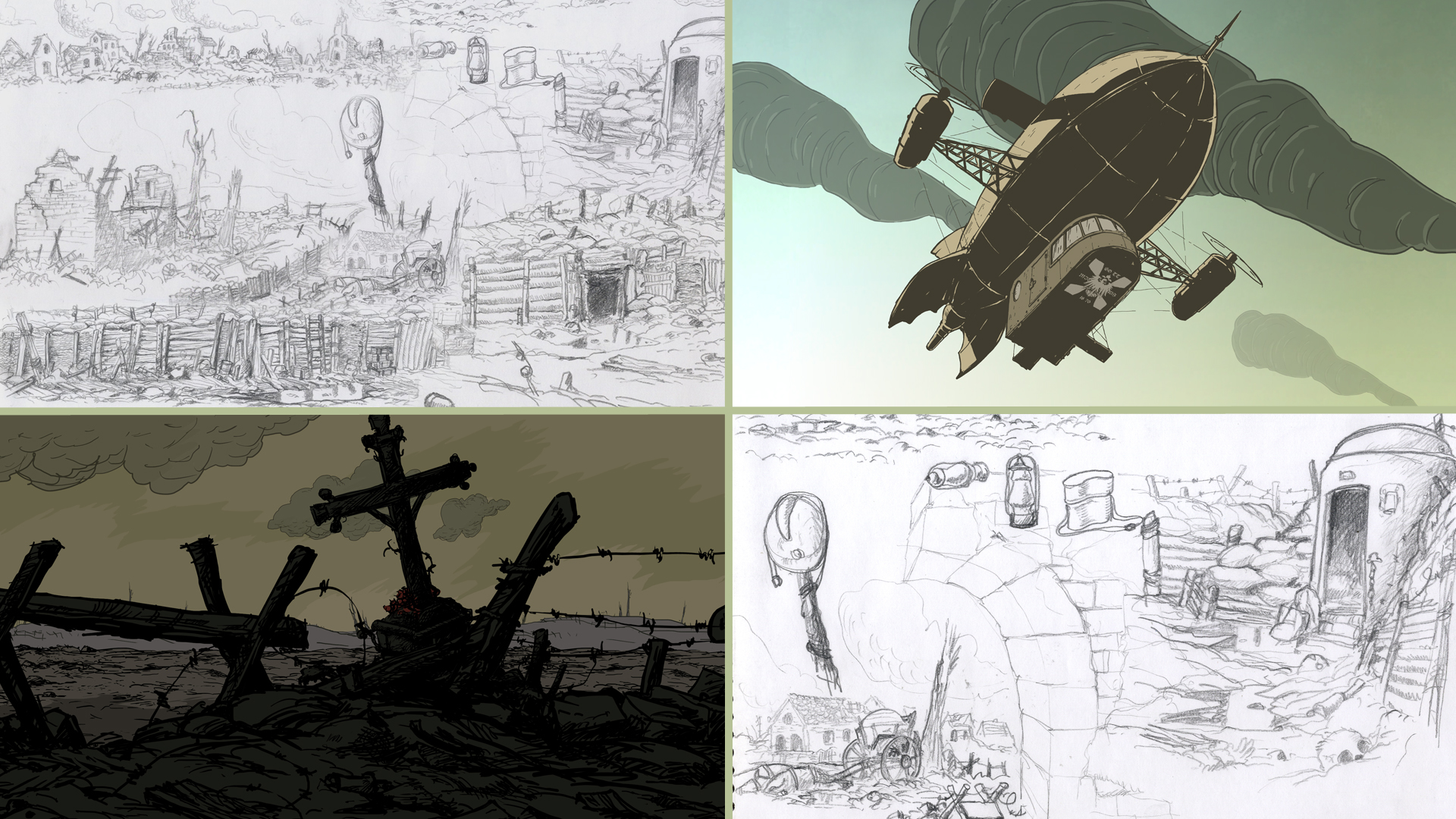ANIMAL’s feature Game Plan asks video game developers to share a bit about their process and some working images from the creation of a recent game. This week, we spoke with Ubisoft Montpellier’s Paul Tumelaire and Yoan Fanise about Valiant Hearts: The Great War, an honest game about World War I.
Valiant Hearts: The Great War is more brutal than it looks. Its designers at the Montpellier, France branch of the major video game development and publishing company Ubisoft sought to make a game that accurately portrays the everyday struggles soldiers experienced during World War I, both on and off the battlefield. But you wouldn’t know it from looking at Valiant Hearts’ comic book-like visuals.

Art Director Paul Tumelaire used the distinct visual style in part because he found it helped him convey the characters’ emotions without the need for dialogue or highly detailed artwork, and in part because as the game’s only artist, he had his work cut out for him. Yet, Tumelaire actually designed the game’s unique visual language before the rest of Valiant Hearts was even conceived, the game’s Content and Audio Director Yoan Fanise told ANIMAL.
Tumelaire had begun sketching World War I-era characters and environments prior to the 2014 centenary of the so-called “Great War,” and Valiant Hearts was born when he and Fanise began to ponder whether they could design a game that would delve into this bloody conflict without falling back on the easy video game tropes that most other war games rely on.

“For me it was important to tell about this war something special and something different. It’s why the Great War was interesting, because a lot of people don’t know about this war, and it was the possibility with a video game to speak about the war and show what happened during this conflict,” Tumelaire told ANIMAL. “It was important to show that it’s possible to speak about a war without guns and explain a lot of things about the life of the soldier in the trenches during this conflict. It was important to avoid the [expectation] of the gamer to bring a gun, and to show that video games can be different.”

And this is exactly what they did. The characters you control in Valiant Hearts will occasionally have to aim a mortar or even drive a tank, but it’s much more common for them to help a fellow soldier, pet their loyal dog Walt, heal a wounded friend, or simply find ink and paper with which to write a letter home. These characters never pick up rifles, but instead run around with soup ladles or just their bare hands. They’ve been conscripted into this fight, or joined out of desperation, and for the most part they don’t want to be there any more than you would.

Most of the game’s challenges involve exploring simple environments and carrying objects back and forth, directing Walt to pull hard-to-reach levers, dodging incoming artillery fire as you charge across a battlefield, or pressing buttons in rhythmic patterns to heal wounded soldiers. But you can also stop to rub Walt’s belly any time you want. Valiant Hearts’ gameplay may be overly simplistic, but Fanise and Tumelaire said that’s because the story always came first. “We started with the story,” Fanise said. “We could have done better [on the gameplay], but the result is what it is.”

And the real purpose of creating Valiant Hearts was to show what the “Great War” was like from the perspective of a German husband and father living in France who’s forcibly separated from his family, deported back to Germany and conscripted by his own country, or a French farmer who encounters his own son-in-law on the battlefield. The individuals’ stories in Valiant Hearts are fictional, but the battles they fight in are real, and the nuggets of history found in diary entries and strewn-about artifacts are highly informative. The game is particularly good at showing the terror of chemical and trench warfare, and the bodies pile higher and higher as the war drags on.

“One of the key points of production was when we realized that we have ancestors who were fighting in that war,” Fanise said. The letters, documents, photos, and other artifacts left behind by his grandfather and the relatives of others on the development team served as inspiration, and they built the story based on the real materials they amassed. The devs also consulted regularly with the historians of France’s Mission Centenaire 14-18, the government commission in charge of WW1 commemoration. The commission officially endorsed Valiant Hearts, vouching for its accuracy.

The game’s story concludes just before the US entered the war in 1917, during an infamous period of widespread mutiny among French soldiers, a reality that’s portrayed unflinchingly in Valiant Hearts when one character accidentally kills a commanding officer and is subsequently executed by firing squad.

Fanise and Tumelaire enjoyed working with the French government historians, but it made them nervous to explain how the game would portray that event. “It was a bit tricky at this moment, but we told them why we chose this ending, and for them it was OK,” Fanise said. “As soon as we didn’t make a judgment about that—we put you in this scene, OK, you’re going to be executed, and your reason to be executed is because you killed someone… I think that was why they accepted that, there was no pushback on that, because there was no judgment.”

Valiant Hearts: The Great War is available on PC, Xbox One, Xbox 360, PS4, PS3, and, as of today, on iOS. The developers confessed that they designed the game with touch screen controls in mind all along, so the newly released iOS version may actually be the definitive one. Head to valianthearts.ubi.com for more info.



